

Back to Interest Pages
Site Map
As everyone is aware, regardless of your view of proceedings, Australia has become a little divided over the last couple of years. Put simply, interstate travel has for almost everyone been forbidden or at least difficult. You would have to have been living under a pretty substantial rock not to have noticed this. Of course Connie & I run a tag-a-long tour business that happens to cross state borders sometimes several times a trip. As you would expect we have been pretty much grounded since May of 2020. In fact we have only completed one commercial trip in two years & 2022 doesn’t look promising either. Now when we put our business together many years ago we didn’t set our model or our pricing with this in mind.....
So what have we been doing since we finished our last trip in 2019? Read on.....
Immediately after getting home to central NSW after the close of our 2019 trips we packed up and moved to another small farm north of Tamworth in the New England area. The last days of September and the full month of October were spent doing this. The reason for this move was simply that my extended family owns a reasonable sized farm there and I had "volunteered" to work on the place as most of the other family members were not able to do so, either from living too far away or not being physically able to handle the harder work. There is more to the story than that but that was the reason for the move in a nutshell. This had all been planned and the sale of the old place & purchase of the new place had been going on while we were out in the desert. We had a month to vacate the old place, so rolling up our sleeves we moved ourselves by doing 17 trips loaded with gear both household & farm. We had some help from good friends and relatives so we were thankfully not alone. Without that help it would have been impossible to get the job done on time. We were both eternally grateful folks, can’t thank you enough.

| Our new place at Watsons Creek, NSW. |

| Loading up moving – I don’t think it’s anyone’s favourite job. |
Of course, the summer of 2019/2020 was the bad fire season......Part way through our moving there was a fire start across the small valley from our new home, bugger. The local Fire Brigade Captain is actually our neighbour and knowing him quite well I gave him a ring and asked if he needed any help. I was told if I could manage a few days that would be great, the plan being to let me guide the bulldozer cutting control lines around the fire edge as they were short-handed. It was figured that I could read a map and not being an official Brigade member that would tuck me out of harms way while still doing something useful. After a discussion with Connie and our dedicated moving team they decided they could do without me for a trip or two so I was released to go firefighting.
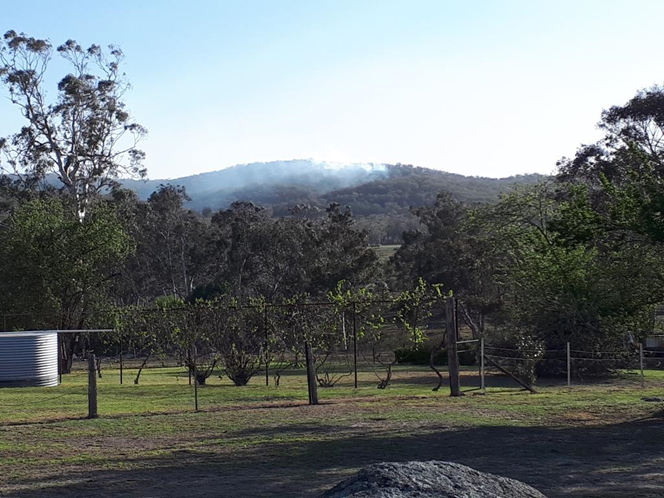
| Den Mt Fire at Watsons Creek NSW in the first day or so, looking from our new home. |

| The same fire two days later after our return with the next load. |
That next morning, Connie and the team headed south for another load and I went to the local Fire Shed in the village just down the road to get my assignment. The boss gave me a quick brief, instructions and a map. I was given a Cat 9 fire unit (Land Cruiser ute) and directed to go and find the dozer that had turned up that morning. (The rules are the heavy equipment must be accompanied by a fire appliance while on a fireground.) As mentioned, our job was to get a containment line cut right around as much as we could and then the Brigade would come along and back burn off that cut. That was the plan as being in the grip of drought we had little to no water supplies and we had no aerial assets available for bombing at that time.
Even from the Fire Shed we could hear the dozer already working so I headed off and after poking around for a little while I found the right track and zeroed in on a yellow machine cutting a single blade-width track along the edge of the mountain timberline. Walked up to the machine and the operator pulled up for a conflab’. Turned out it was Paul Summers from Nundle. I knew Paul from another fire in the area a couple of years before. We’d been doing the same job then as well. He being a top notch operator and having been an RFS Group Officer in the past meant the next few days were going to go smoothly, even if we had a bit of trouble, as weird as that may sound.
Four days I spent on that job while Paul & I got a 10-15km containment line around what was known as the Den Mountain Fire. At one stage the country was that rough that we were both on foot doing a recce’ trying to find a way up and over a scrubby timbered rocky ridge. We got a cut through eventually and by chance the next night the fire burnt to it and pulled up. During the last day I was there the Brigade had caught up to us and we were right in the back burning operation. Bit of a shock after being just us way out in front of the fire on our own.

| This was the Den Mt Fire looking from the western side where I did most of my work. |

| Paul Summers D6T cutting containment line Den Mt Fire October 2019. In rough country very often your fire break will be a long way from the actual fire front. That is where back burning comes into play and greatly widens the strip of country that can’t burn in front of a fire. |
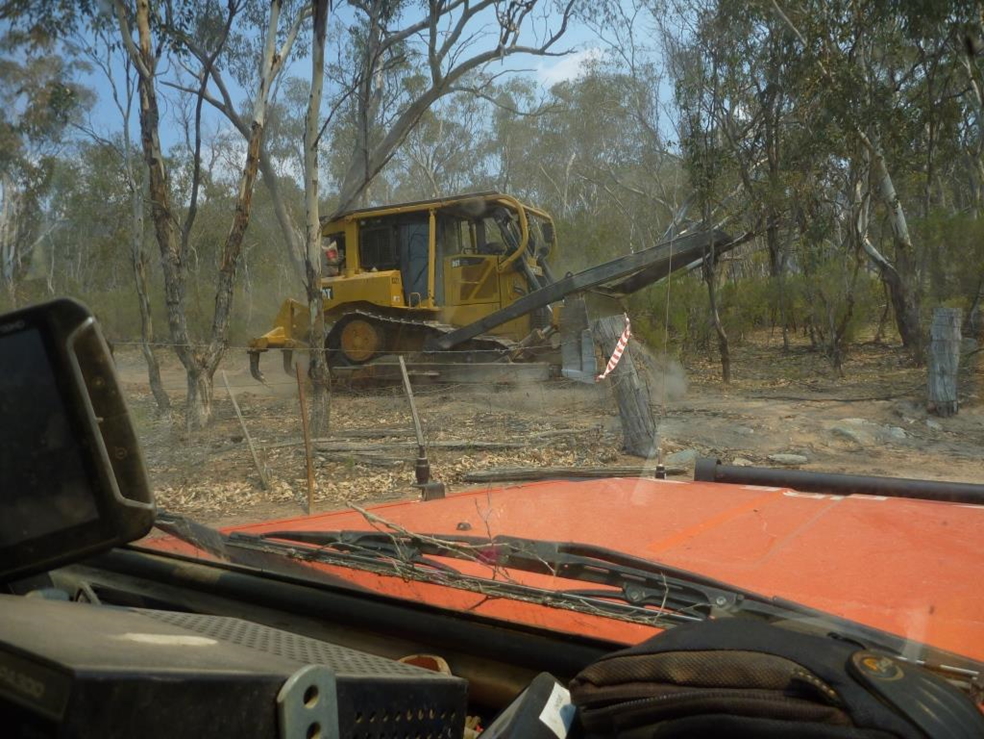
| Opening up an old track for better RFS access to the Den Mt Fire, October 2019. Notice how dry it is and the fuel on the ground in the bush. |
Just a little point about that 2019/2020 fire season, as you may all remember it was a terrific drought over most of the country that the fires were in. This proved to be of great benefit for firefighting in general. You may wonder why? Well think about it this way, there was simply no grass growth of any description in open cleared paddocks. So if a fire was in bush country with plenty of fuel to burn and then came out into the open where there was none it literally just stopped dead or just fizzled out and was much easier to handle. This was certainly the case in the New England and all the districts I was familiar with at the time. If it had been a normal season with normal grass fuel loads in paddocks there would have been far more trouble, something to think about.
In the end that Den Mountain Fire ran for 3 weeks and barely a tank of water was used the entire time and we only had one retardant drop over a remote fire break put in by hand by a RAFT crew. I’ll include a picture of that. As that summer ground on we had plenty more fires in the district.

| The far south west sector of that fire, in the middle you can see a pink line that is retardant dropped from an aircraft. Retardant reduces the ability of fuel to burn, hence the name. The only trouble with dropping it onto trees is that the liquid doesn’t all get to the ground so there is nothing like a 100% coverage, fires can burn through and this one did. |
After all of that excitement it was back to the job of moving which Connie and our friends had been doing a mighty job of while I was absent. They were glad to see me back on the job in any case. Some of the very heavy items could now be tackled! I can’t remember how many loads we did once I got back to work but it was during that time on a trip back north that just out of Wellington I ran over something on the road that somehow flipped up and punched a good sized hole right into the front diff’ housing. I recall the clunk but didn’t think much of it at the time. Luckily we always pulled up for smoko about 10 minutes up the road. This particular day I was curious and was about to have a look when I could already see oil on the ground. Oh dear, I didn’t have any spare oil with me being in civilisation so the only thing was to jam a stick into the hole and limp back to Wellington, get some oil, fill it up and go back and do a repair. Connie and the boys carried on and I got going, albeit very carefully. Expecting the diff to start growling any minute I got back to town and picked up some gear oil. Found a better fitting stick, bashed it in, filled it up and got on my way.

| Amazing what you have to do at times to keep mobile. |
The move completed by the end of October then we spent November getting things sorted out and put away as best we could with the limited shed room. I think we had a few days off in there as well as the move was non-stop without a break at all.
During December a bulldozer from Tamworth was working in the local area doing rural work so after finishing up on two of the neighbours places I offered the machine work cutting some dams and also a small amount of track making. Work for about a week was agreed upon and so the dozer walked onto the old family farm and away we went. With a couple of pesky breakdowns and some Total Fire Ban days (where we couldn’t work) after about a fortnight we had 5 new dams, another cleaned out & larger and a couple of sections of track cut to bypass some steep sections that were difficult to negotiate. I was very pleased with the work, just needed some rain.......

| Smoke from the 2019-2020 fire season, wasn’t always this bad. |

| D6H cutting a new dam in what is known as the Cutting Paddock, December 2019. |
While I was doing these few things Connie was getting her "new" house organised and also ploughing back into getting the tour work up to date, including the photos and trip logs for all of our travellers. This is a huge job and takes weeks to finalise. I also had my own paperwork regarding the trips with reports & summaries to write up. (Turned out that later I had plenty of time!)
After the dozer work was completed in December I then started to use our mobile sawmill to cut boards of various sizes for the planned jobs that were coming up. I spent weeks on this while also helping with more firefighting in the local area. We had several lightning strikes on two of the neighbours places which required quite a bit of gut busting, being in rough country inaccessible to vehicles, so back to cutting breaks by hand for a few days. All the while the district had some large fires out of control as the summer went on. The Moonbi Fire in January was particularly savage and cut the New England Highway for some time. It was lit by a local arsonist on a very bad day, thanks mate. Of course as with most of NSW and beyond the area was blanketed by smoke for what seemed like months.
As I mentioned, I was cutting boards. These were mostly 4x2, 4x1 & 3x1 for shed building jobs that were slated on the very long to-do list. It was all Stringybark timber and once cut was stacked to air dry in the old woolshed on the place. This can be pretty heavy work in hot dry weather but such is life. Very different from touring.....

| This is our 7" Lucas mobile sawmill set up on the old farm cutting Stringybark - Dec 2019. |

| One of many loads of board cut in the bush with our mill – Dec 2019. |
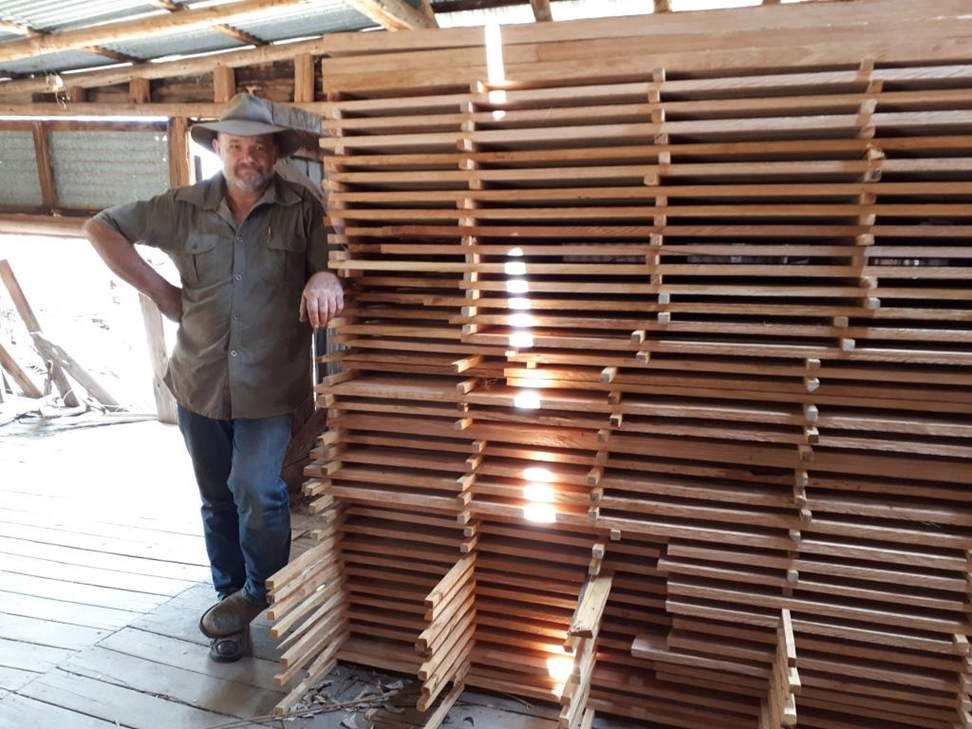
| Boards stacked up to air dry. One of my first attempts so I have learnt a few things since then. The little 1x1 sticks are cut out of the same logs, very little of use goes to waste. |
I think cutting boards went on well into the summer as well as normal work about both farms, where we live at Watsons Creek and the old farm 10kms away. Both places have quite a bit of bush on them and have been neglected over the years so even during a drought there is rubbish and unwanted things growing up in all the paddocks. I pottered about in the cool of the mornings with a mattock for weeks on end. Little did I know the drought was about to break!
Having run out of room to stack any more timber the next big job was getting the ground prepared for a concrete slab for a new steel shed I had bought and been delivered. I borrowed a 3PL grader blade for the tractor and made a start levelling off a site for the pad. Given it was horribly dry this took quite some time as the ground was almost concrete itself. Eventually scraping away I was able to come up with a flat area large enough. Then the job of digging the beam trenches and whatever else needed doing. This was all done by hand and a good portion of the site turned out to be decaying granite with some sections being solid. I chipped, picked and barred my way through it over weeks it seemed but eventually it came up really well. Next job was the concrete and a local fella got that job of forming it up and doing the job properly. I haven’t done much cement work in my time and certainly wasn’t confident in tackling a slab on my own! So April 2020 the slab was poured and finished and I was the new owner of a base for a new shed, whacko.

| Preparation for 12x10m concrete slab for a shed – levelled with the tractor and the rest cut by hand. The two pads in the middle are for the two-post vehicle hoist - March/April 2020. |

| April 2020 – nearly finished. |
By this stage Connie was making noises about starting to grow veggies, something she’d always wanted to do. We sat down and tried to figure out what was needed and came up with a fairly ambitious plan for a shade-house full of garden beds with a covered end and work bench. Ultimately there would need to be a watering system and the list goes on.....So putting my steel shed on hold I went back to the bush with the mill and started cutting wood again. Oh boy, it wasn’t long after that the drought started to break and the rain started and hasn’t really stopped even now.
The first job was to cut some poles for the shade-house frame. I had already been cutting poles for shed projects in March so after the concrete job I went back to it hoping to get enough to start the shade-house. I wasn’t satisfied to use round bush posts so I decided to make square posts shaped the same as my great grandfather used to. However this time I would use a sawmill where he did them by hand with an adze. The other timber to start cutting was for the garden beds. Needed a fair amount of 6x2" boards up to 10’ long, for anyone curious no I don’t use metric for this sort of work. In my opinion bush work is much easier with the old system, fancy that. Think about it, even the timber you buy now is still the old sizes. Dressed timber is the old size less the amount needed to smooth them up. Over quite a few months on and off between other jobs I slowly got together enough material to make everything.
One of the other jobs was working for a neighbour fencing along several kilometres of boundary. We were at this for weeks and more than once we knocked off due to rain and in one instance we didn’t even start as it was snowing, yes snow.

| Watsons Creek NSW snowfall on June 2nd 2020. Watsons Creek is at about 800m and does get snow now and again. |
So as well as the timber needed for the shade-house project I also needed a flat spot to build the frame which was 50’ long and 25’ wide. Once again got the tractor going and inside the house yard started levelling off a pad big enough to fit this thing. Once that was done I could then start putting in posts and positioning the garden beds as I put them together. I had worked it all out already so just needed to make the jigsaw pieces and put them in place. At that stage Connie knew what I was doing but as I found out later she didn’t realise the scope of what I had planned.
Obviously we were not touring, the virus, or the response to the virus more accurately, had made it impossible to conduct our trips over various state borders. We had full bookings for 2020 and not being able to do the work was a fair sort of financial blow. The Government introduced Jobkeeper during that time and we applied and were successful even though our business didn’t quite fit into any category they had listed. However the criteria we could fulfil was the pretty much zero income. For both Connie & myself this was our first support from the Australian taxpayer, given our ages I’d like to think we had already contributed enough to cover it. In my case with the part time work fencing and a few other small jobs plus our rainy day money we kept up with the bills.

| Pad levelled off to build the shade-house for growing veggies – mid 2020. |
Another point to make was that when we moved to this place I intended to get some sheep and slowly build up a mob of some size to run on both the little farm where we now live and the old farm up the road. Of course when we got here it was peak drought and there was no water or if there was water no feed. I held off buying stock even though they were cheap. Of course in due time it started to rain and within days of it doing so stock prices of both sheep and cattle went through the roof and to date have kept going to some degree. By the time this came about it looked like our touring work was a bust so I wanted to keep what cash we had in hand for the uncertain future and uncertain it became. The sheep would have to wait. As I type this story that was over 18 months ago and as I have explained we have managed to get by. Connie & I are not extravagant people and only go to town once a fortnight so living the quiet life has its benefits when the tight times come, you don’t have to tighten your belt, it already is.

| Building one of the first of ten garden beds. The boards are 6x2" Stringybark and the corner blocks are 4x4" Yellow Box. |
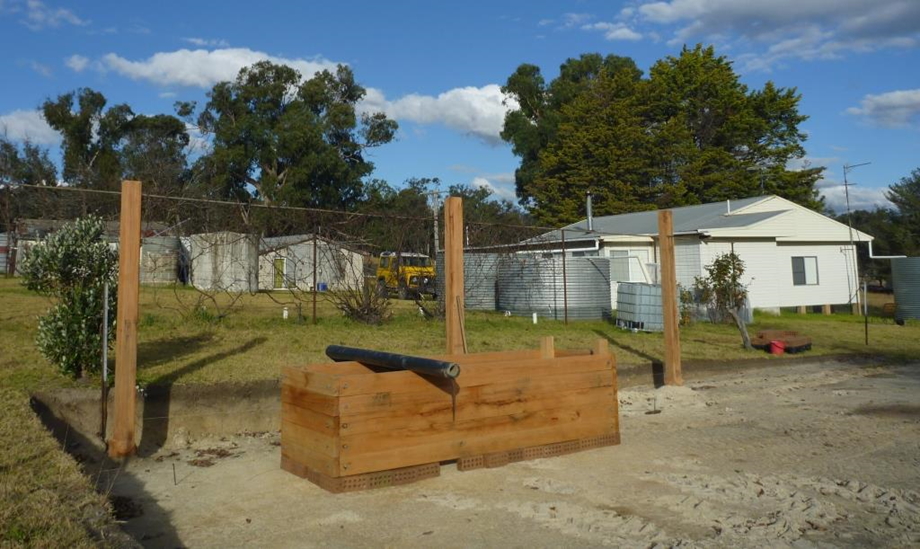
| The first garden bed in place and the first few posts put in – winter 2020. Just the start of a big project....... |
During our first 12 months at the new place we had quite a few visitors call in. Almost all of them were desert travellers from our trips and they had all become friends that we correspond with regularly, even if we don’t see them travelling. Most stayed overnight, some stayed for a few days and a couple stayed for a week or more and I’d take them up the bush and do some proper old fashioned bush work with a few modern tricks thrown in. I didn’t think to take any pictures of those times and now regret not doing so. Very few people take pictures of what they think is normal everyday work, I guess it’s different now with phone cameras but even so if you are poking along getting some work done, taking pictures is wasting time.

| Bit hard to see here but the posts are left round on the bottom and with the mill I squared the tops of them. These posts are 6x6" Stringybark, the square posts are easy to line up and build with during construction. |
Apart from timber work, paddock work, days inside due to rain & snow the other "hobby" that was beginning to take some time was the local Fire Brigade. As mentioned early in this article our neighbour is also the local Brigade Captain and fairly pro-active in regard to pretty much everything to do with the RFS. So even while I wasn’t a fully-fledged member of the Watsons Creek Brigade over that 2019-2020 summer I was actually quite busy now & again with various fires. The reason was quite simple, during the week just about all the volunteer Brigade members were working in Tamworth so any fire that came up on a week day the Captain was pretty much on his own. With me at home during the summer while ever we were touring it was an ideal time to recruit a new member. So as that summer wore on there would be a phone call at any time with a question about going to a fire or some such. I never refused and with the several lightning strikes we did have sometimes it was just the Captain and I in attendance and boy didn’t we work at it. So as that mongrel season settled down and the weather cooled I joined the Brigade officially and was slotted in to do some training very quickly. I’ll just add here that my father was a volunteer for 50 years and actually went to his first fires in Watsons Creek in 1957. All the while growing up he was in whatever Brigade was nearest to where we were at the time and I well remember going to fires as a matter of course, member or not. Years ago if smoke went up it was all hands on deck. As a kid I can well remember putting fire out with a wet bag or a good solid leafy branch from the nearest tree. It is amazing what you can do with an ordinary shovel if you have one.
Suffice to say, the modern Fire Brigade system is very different and verging on what I would call semi-professional, particularly the Brigades closer to town, these are often called Village Brigades as their role is split between bush fires and structure fires and similar. Anyway, I was slowly dragged into it all not kicking and screaming and have completed quite a bit of training to date and also was able to get accredited for Tree Falling Fireline (TFF) via the RPL system. The captain also pushed a few buttons and got me onto a Fire Permit course so now I’m a Permit Officer as well. It never ends....Years ago before I met Connie and the tours started I worked in the bush cutting commercial log, both softwood and hardwood. Most of the time I was operating forest machines of various descriptions but now and again I would have to fall trees at the stump, meaning by chainsaw. With that experience and what I had been doing lately I was given a challenge test of a big difficult tree and passed.
Out of interest, there are three levels of chainsaw operator in the RFS and I guess across the board in all the industries that use a saw. I can’t remember now but think even in my time commercial Forestry was the same. I had an Advanced ticket at that time.
The Captain & I had been trying to lift the chainsaw capacity of the Brigade as it never made sense to have a bush brigade that wasn’t officially allowed to use a saw much! I even discussed this with the brass in town. So over that period a few of the other members got their TFT qualification and the Captain got his TFI as well. Once that was all settled the Brigade bought itself a new chainsaw and the RFS supplied the rest of the kit. My one gripe was that the RFS use "small" chainsaws, nothing wrong with that but I’ve pretty much always used bigger saws and given our responsibilities on a fireground if we got a new saw for the Brigade I wanted a big one and the Brigade agreed. Long story short (thank gawd you're thinking) I now carry around with me almost everywhere a 95cc chainsaw with all the gear and my RFS kit so I’m ready to go if the alarm goes off, and it does now and again.
Still on the Brigade stuff, Connie got involved as well. The Brigade had three backpack blowers (leaf blowers on steroids) and a few other things including the new saw that needed bags and coverings. After some discussion Connie took on the job of making these things out of canvas with her very good late model industrial sewing machine. Took some fiddling to get a pattern right as these blowers are quite a funny shape but eventually Connie produced a very good quality product that the Brigade is extremely happy with.

| 2 of the 3 blowers that the Watsons Creek Brigade owns. |
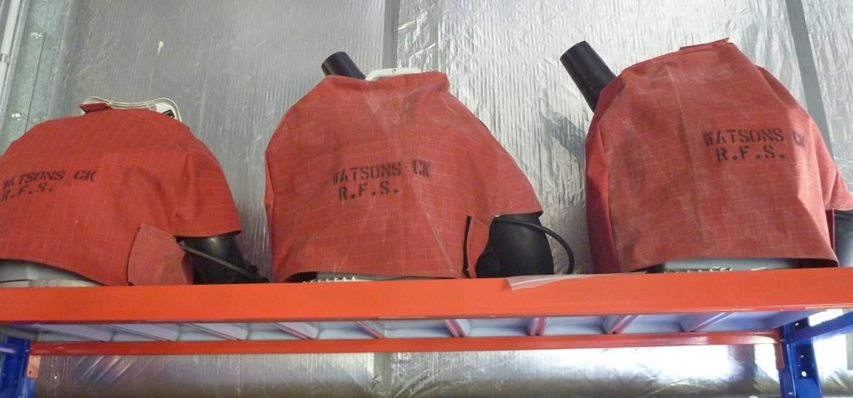
| The three stooges - Larry, Curly & Moe, our three blowers. Picture doesn’t show much detail – look them up on the internet, there are videos of them working at fires. |

| The new "big saw" kit for the Watsons Creek RFS Brigade. Husky 395, 24" & 28" bars, spare chains, axe, wedges, tool kit & chaps (the yellow bag is for the chaps). Already had a few call outs with this gear and it all works really well, very happy with it. |
The winter of 2020 gave way eventually to spring and summer. Our last frost was in October. During that time I was still cutting timber boards, firewood for home and doing paddock work of various kinds depending on how wet the country was. More work for neighbours came along and for a week or more I was out in rough country cutting stands of Black Cypress Pine which is an invasive pest even though it is native. At other times for weeks there was no way you could drive anywhere in a paddock due to the wet conditions, you would just go down and stay there. It made life interesting at times.
Our rainfall for the year of 2020 was just over 40" with an average year being in the mid 30s. Only a few locals could remember a year as wet as that one. At least it was a huge change from the previous dry years. Feed was growing in paddocks, dams were near full or overflowing and local graziers had given up feeding stock for the first time in 2 or 3 years.
Given it was pretty wet over the summer we only had a few call-outs for the fire. A burning vehicle and a couple of lightning-struck trees. One of which was a fair size and I had to drop him in the dark. Can’t recall falling timber by torchlight before! From memory we had a false alarm as well which turned out to be someone burning off that had a permit. A passer-by rang 000 so we had to go and have a look.
Once I had finished building garden beds and cutting the shade-house frame boards I got them assembled and placed in the correct spots. As usual with projects, sometimes they get a little out of hand.

| 10x12m Shed frame by the end of March 2021 – getting there. Felt odd working in steel again after doing so much timber work. |
As Easter approached the family decided on a working bee on the old farm to start rebuilding one of the old timber sheds my great grand father built in the 1950s. Cousins came up for the four day weekend and made a start on replacing the wooden shed posts. My job was to find, cut, shape and supply six posts. Bit of a balancing act but the boys did well.

| Takes a while to figure out what to do so the whole thing doesn’t tip over, a gentle touch is needed. |

| Squaring Yellow Box pole to make shed posts, having done a couple of dozen now it is much easier but leaving the round butt was a fiddle to begin with – Easter 2021. |
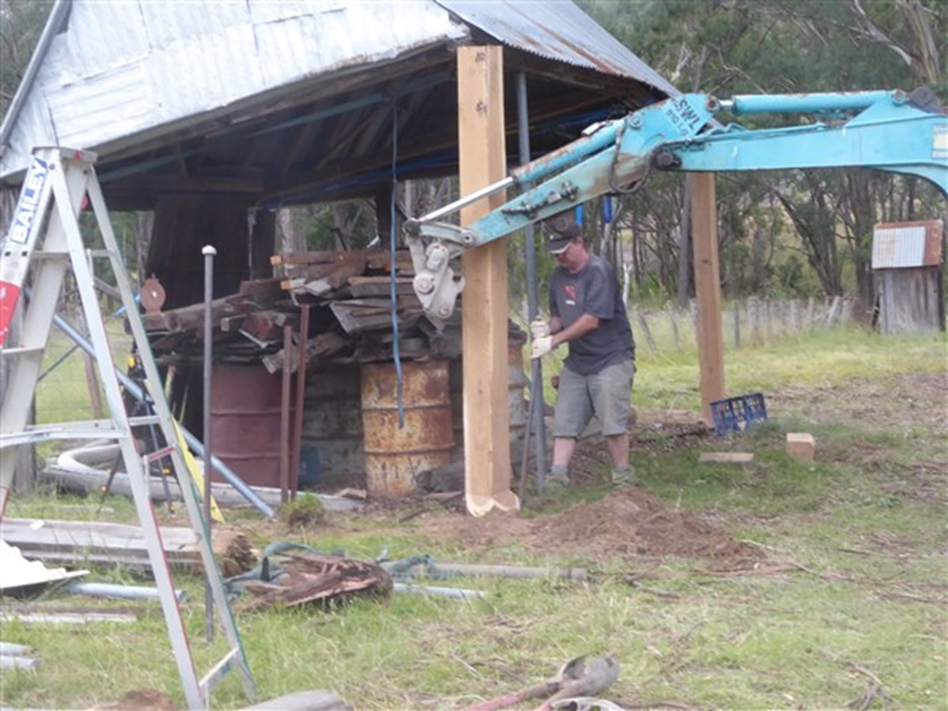
| You can clearly see how bad things were on the old posts. |

| Three new posts on the eastern side of what is called the "car shed". The other three posts are cut and ready to go whenever the boys are up next and need some exercise – Easter 2021. |
After Easter, the virus response had settled down and state borders were open, apart from WA which at the time you had to quarantine before entering. With travel possible Connie & I went ahead & prepared a couple of short two week tours in outback SA. Given the cold weather was on the way you would have to be foolish to think a respiratory virus wouldn’t again make itself unpopular, so we didn’t know how things would go. We had plenty of people itching to get away after 12 months of having to stay at home so we started planning and away we went.
Our first foray was the eastern end of the Nullarbor, a place where we have spent quite a bit of time over the years. Nice & quiet with plenty to see. We had a full trip with seven vehicles behind us and over the two weeks we had a good time even though the weather chopped & changed endlessly. Nullarbor can be a bit funny weather wise and May 2021 it didn’t disappoint. Luckily for most of the wet nights we were in good spots so no harm done.
With several customers from Victoria, quite a few folk were listening to the radio in the evenings to catch up with the latest virus response measures. It soon became apparent that Victoria was going to lock down again. Our Victorians were not that happy to head home at the end of the trip not knowing when they might be able to "escape" again. For Connie & myself we had another problem, our next trip was at risk as all the participants were from Victoria! We did some ringing around and found that most of them had just got home from other journeys and were not ready to get back on the road before the borders closed, they were stuck & so were we, we didn’t have any customers! With little to do we headed for home. Looked like only one trip for our little tag-a-long business in 2021.

| Western Myall & Mallee camp spot that we have used before, they are great spots – May 2021. Connie & I had been in the bush for ages at home but it was nice to get back to remote country. |
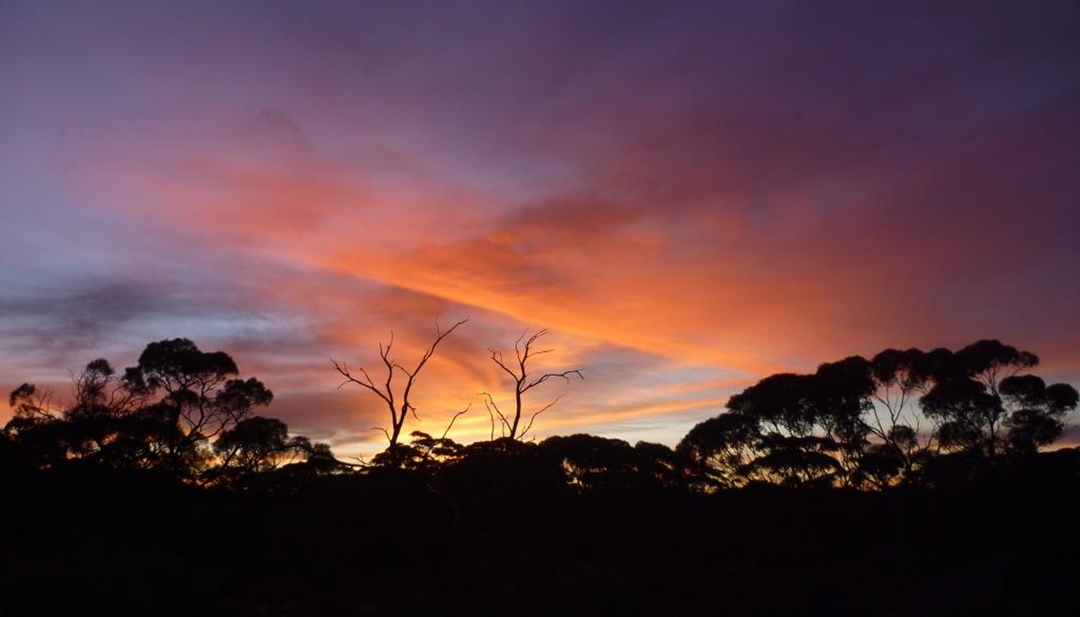
| Everyone should have the chance to see many of these throughout their lives but sadly I don’t think that happens for the majority. TV or computer screen versions don’t come close to the real thing. Nullarbor, May 2021. |
Home again, we spent the next month or so finishing off trip paperwork, talking to customers and so on. I had time to write up a number of articles which Connie posted to our website later in the year after winter eased off. Pretty hard to keep a business website ticking over when nothing is happening, so a few new things to read couldn’t do any harm.
As the cold season dragged on jobs came and went, a bit of fencing here, bit of firewood there, I remember repairing some tyres (I’m getting out of practice). Pottered about with some paddock work chasing weeds and of course at times it wouldn’t stop raining so things just ground to a halt for days at a time. Our last frosts were in October, at our elevation the cold weather hangs on a bit longer than normal. We even had the fire lit in the house a couple of times in November.
More RFS Fire Brigade training both for myself and Connie as she had joined our Brigade as well. Connie’s first aid background earned immediate qualifications through the RPL system and at the end of winter Connie also did her first big training course which covers firefighting and using all the gear, pumps, hoses and the like. As the spring weather kicked in we began having training time down at the Fire Shed about once a month so those that were interested could keep their hand in with doing firefighting work. The last couple of years had been quiet and it doesn’t take long to forget the finer details.
As the weather slowly warmed the amount of feed (grass) in paddocks was amazing considering not that long ago it was pretty much bare dirt in all directions. On both our places we didn’t have any stock on so the extra growth wasn’t being eaten off. Not knowing what the summer would bring I determined to burn off as much country as I could before the Permit season began on October 1st. This would do two things, reduce the fuel load and perhaps slow a fire if we had trouble before Christmas. The other thing being fire rejuvenates the country and makes grass growth much more sweet and soft. So during late August and into September I spent nearly all of my time preparing to burn paddocks and then doing the burning. Turned out to be a slow process as given the wet conditions I couldn’t use the tractor to plough fire breaks around paddock edges like normal. I spent weeks with a whipper snipper cutting breaks and then raking the cut grass off. Where I could I used the ride-on mower, absolutely ridiculous to be cutting fire breaks with a lawn mower on a farm but there wasn’t any other way. The biggest trouble with our little farm where we live is that one of the paddocks is intertwined with the local houses in the village. Obviously we had to be careful and thankfully all the owners were more than happy to reduce the fuel load/fire potential around their house blocks. In the end it all worked perfectly and as long as we got the breeze right we could keep the fire intensity low and get a full cool burn over pretty much all of the paddock. Sometimes though you would need a bit of breeze to make it travel better so you quickly learnt how to use the weather to your advantage. All in all I learnt a great deal about fire management while doing my own country. It had been many years since I had done anything like that. I well remember as a youngster chasing burn-offs that my father had lit. I recall they always seemed to get a bit out of hand!

| The oldest farm tool, a good burn off does wonders for grass growth – September 2021. |

| This is a good example of a cool burn. The fire is low intensity and burning into the gentle breeze. This type of fire will only burn off the top dry grass and leave the green lower cover completely intact. It protects insects and the environment closest to the ground. Most things are well adapted to cool burn events. September 2021. |
Once those burns were done the Permit season started and I moved onto other jobs. More fencing and paddock work, a little bit of road maintenance where the wet weather had made an impact and finally got back to working on Connie’s shade-house. On that front the biggest job was to finish the work bench and build some shelves. We also ordered a big roll of shade cloth material and I got that cut to shape, Connie ordered some of the special thread needed for that work and we eventually sewed the required pieces together. Because the shade cloth pieces were so large we needed to drag the sewing machine outside to get it done. We obviously picked a fine day!

| Home grown spuds, how can life get any better I ask you? |

| Home grown Strawberries, little nuggets of goodness! |

| This is the completed work bench in the end of Connie’s shade house. That is pretty much what I had in mind when I planned it 18 months ago – October 2021. |

| Small set of shelves built on the end of the work bench. Other shelves will be built for seedlings etc. October 2021. |
The month of November rolled in and apart from a few jobs it has just been wet, seriously needed gumboots in the paddock wet. None of us were game to do much farm work. Anything that needed doing was done on foot or quad bike if you had one. Even that is fraught with "danger". For the month to the 27th we had 260mm of rain or more than 10” in the old proper scale.
So that is what Connie & I have been up to, well at least the major jobs. Nobody knows how things will go in the future, the response to the virus has caused some problems and I think the repercussions will flow on for some years. I’m just glad we live in the bush well away from cities and even large towns and are becoming more self-sufficient. For us if we don’t listen to the news then everything seems just like normal.
Safe travels everyone. We may or may not see you in the bush.
Mick Hutton
Copyright: December 2021
BEADELL TOURS
Mobile : 0408 841 447
Email : Beadell Tours
ABN : 40 947 959 130